Magic Cooler: Thermalright Archon Review

Thermalright one more time pleased those who value efficient air-coolers with a new super-cooler. Read our exclusive review for details!
Very little time has passed since two new coolers from Thermalright Inc saw the light of day: HR-02 and Silver Arrow, but the company is already introducing their new creation – Thermalright Archon. According to the official info, the name for this new cooler was taken from the popular StarCraft 2 game, where one of the magical psionic support units from the Protoss race armed with a plasmic shield is called “Dark Archon”:

We have no idea why Thermalright decided to go with this particular name for their new cooling product. It made more sense to us to explain the “archon” name by the external similarity between the cooler heatsink and the palearctic butterflies. But later on it turned out that the new cooler does indeed have something magical about it. so, let us start from the very beginning.
Packaging and Accessories
The packaging of this new cooler is designed in Thermalright’s traditional “Spartan” manner: it is a medium sized box of thick brown cardboard:

There are inserts made of polyurethane foam inside the box that hold the heatsink and the fan. There is a flat box with accessories inserted right next to them. Among the included accessories are two retention kits for AMD and Intel platforms, wire clips for two fans, Thermalright Chill Factor III thermal compound and two sets of rubber and silicone shock-absorbing pads for the fans:
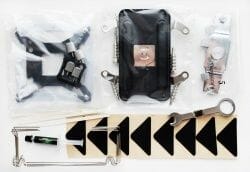
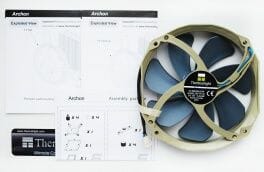
Besides that, Thermalright Archon comes with two installation manuals, a company logo sticker and one 140 mm Thermalright TY-140 fan.
Thermalright Archon is made in China and comes with a one-year warranty. It is priced at $79.95.
Design and Functionality
At first glance, we see just another tower cooler, although this one is 170 mm tall:
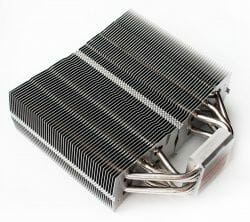
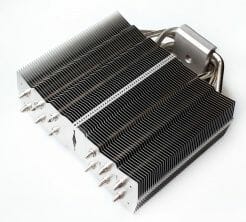
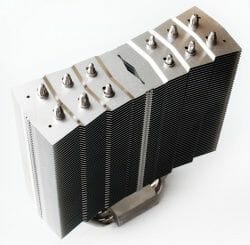
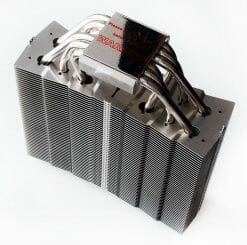
But that is only the first impression. The heatsink weighs 806 grams and the layout below shows its dimensions:
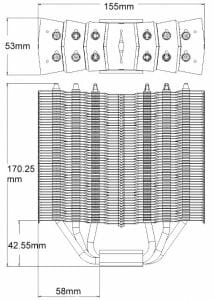
Well, Thermalright Archon heatsink consists of 50 aluminum plates, each 0.5 mm thick, that sit on six heatpipes 6 mm in diameter. The heatpipes go through a copper base plate and all contact surfaces between the heatpipes and the base as well as the heatpipes and heatsink plates are soldered together. The entire heatsink is nickel-plated:
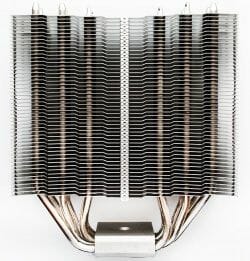
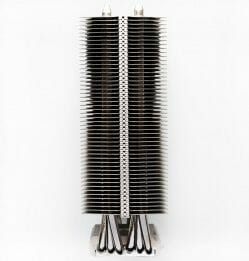
The gap between the heatsink plates is 2.0 mm. the calculated effective heatsink surface measures around 9,000 cm2, which is more than 2,500 cm2 smaller than by Silver Arrow (11,560 cm2), but a little bigger than by ThermoLab BARAM 2010 (8,900 cm2). The heatsink plates have four unique ledges on each side. There is also a uniquely shaped opening cut out in the very center of the heatsink:
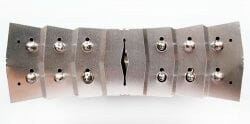
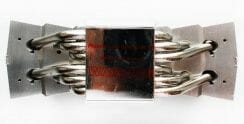
At the same time the heatsink narrows down to 45 mm in its central part and widens up to 55 mm towards the ends. At this point we assume that all these shaping peculiarities are intended to reduce the fan airflow resistance and increase the ultimate cooling efficiency of the product.
The key peculiarity of Thermalright Archon is the way its heatpipes are laid out inside the heatsink body. As you can see in the photographs above, the heatpipes inside the heatsink are lined up in two rows and are spaced out at the same distance from one another, which should already ensure even heat distribution over the heatsink plates. Moreover, check out where these heatpipes come out of the base plate and where they go inside the heatsink:
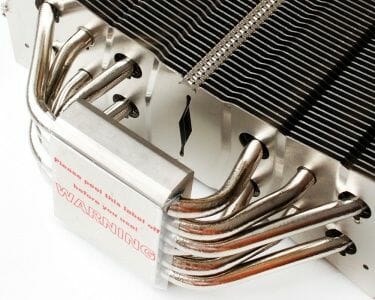
We all know that central heatpipes heat most of all. And as you can see, Thermalright engineers made sure that these hottest heatpipes would be as far from one another as possible. This should ensure that the heat dissipation from the heatpipes to the heatsink occurs in the fastest and most effective way. Everything is very simple, but no other cooling solution maker has come up with anything like that before.
The thinnest part of the base plate where heatpipes lying inside special grooves are soldered to it is 3 mm:
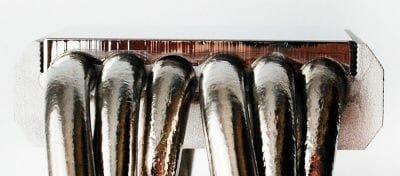
The base plate contact surface is unevenly prominent, which is in fact quite typical of Thermalright products:
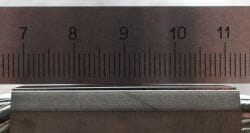
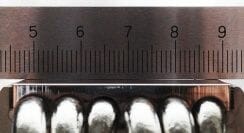
As for the finish quality, the base of Thermalright Archon cooler is impeccable:
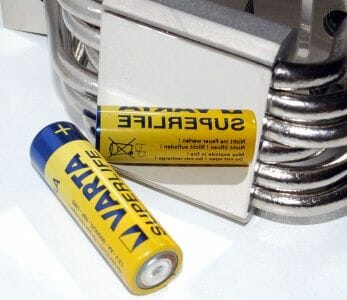
Below you can see the thermal compound imprints on the cooler base from the CPU heat-spreader:
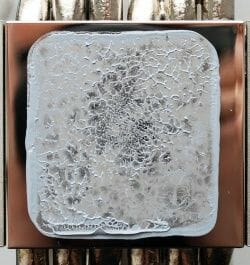
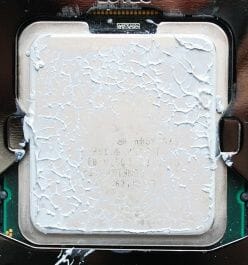
Thermalright Archon is equipped with one Thermalright TY-140 fan, which we have already reviewed before in our article called “140 mm Fan Roundup”. You can use rubber triangle pads and silicone strips with one sticky side to eliminate the vibrations transfer from the fan to Thermalright Archon heatsink. We learned by trial (and not error) that there are only two short segments along the sides of the fan that contact the heatsink. This is where we stuck the anti-vibration silicone strips:
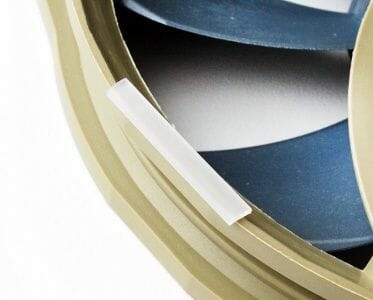
The fan is attached to the heatsink using two wire clips included with the cooler. They go into the special retention holes in the heatsink and then need to be pushed until click to lock in the retention holes of the fan:
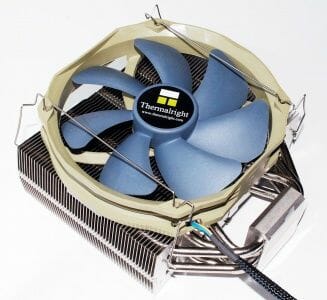
There are two sets of clips included with the cooler, so you may armor your Thermalright Archon cooler with two 140 mm or two 120 mm fans, if you wish.
Compatibility and Installation Tips
Thermalright Archon is compatible with all contemporary platforms and it installs exactly the same way as Thermalright Venomous X. the installation procedure is described in detail in two manuals: for Intel and for AMD processors.
If you install the cooler onto an LGA1366 mainboard, the memory slot next to the processor socket will never be blocked. Moreover, there will be an additional 10-15 mm gap (depending on the mainboard) between the closest memory slot and the cooler fan:
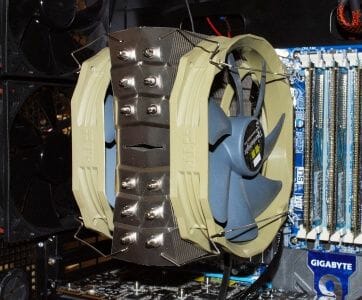
This is another unique peculiarity of Thermalright Archon: it can be used in systems with tall memory heat-spreaders. I have to remind you that the distance between the contact surface of the cooler base and the lowest heatsink plate is 42.6 mm, which should also cause absolutely no interference issues with the heatsinks over the voltage regulator components. At the same time, however, there may be problems with the side panel of the system case, which may not be able to close (which is our case: the side panel of our Antec Twelve Hundred system case hit against the heatpipe ends of this tall CPU cooler). That is why we had to keep the side panel removed during our test session.
Technical Specifications and Recommended Pricing
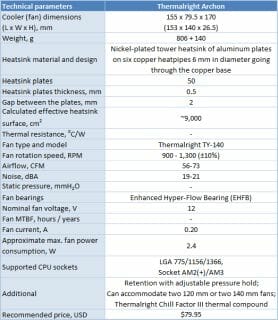
Testbed and Methods
Since we couldn’t close the side panel in our system case with Thermalright Archon cooler installed, we performed all tests inside a system case with a removed side panel. Here is our testbed configuration:
- Mainboard: Gigabyte GA-X58-UD9 (Intel X58 Express, LGA 1366, BIOS F5g);
- Processor: Intel Core i7-980X Extreme Edition, 3.33 GHz, 1.225 V, 6 x 256 KB L2, 12 MB L3 (Gulftown, B1);
- Thermal interface: Arctic Cooling MX-2;
- Graphics card: ATI Radeon HD 5770 1 GB GDDR5 128 bit, 850/4800 MHz;
- Memory: DDR3 3 x 2 GB OCZ Platinum Low-Voltage Triple Channel (Spec: 1600MHz / 7-7-7-24 / 1.65 V);
- System drive: RAID-0 of 2 x Kingston V-series SNV425S2128GB SSD (SATA-II, 128 GB, MLC, Toshiba TC58NCF618G3T controller);
- Drive for programs and games: Western Digital VelociRaptor (300GB, SATA-II, 10000 RPM, 16MB cache, NCQ) inside Scythe Quiet Drive 3.5” HDD silencer and cooler;
- Backup drive: Samsung Ecogreen F4 HD204UI (SATA-II, 2 TB, 5400 RPM, 32 MB, NCQ);
- System case: Antec Twelve Hundred (front panel: three Noiseblocker NB-Multiframe S-Series MF12-S2 fans at 900 RPM; back panel: two Noiseblocker NB-BlackSilentPRO PL-1 fans at 900 RPM; top panel: standard 200 mm fan at 400 RPM; side panel removed);
- Control and monitoring panel: Zalman ZM-MFC2;
- Power supply: Xigmatek “No Rules Power” NRP-HC1501 1500 W (with a default 140 mm fan).
When we tested the coolers with fans installed, we overclocked our six-core processor (with its default protuberant heat-spreader) with the multiplier set at 25x and “Load-Line Calibration” enabled to 4.46 GHz. The nominal processor Vcore was increased to 1.45625 V in the mainboard BIOS:
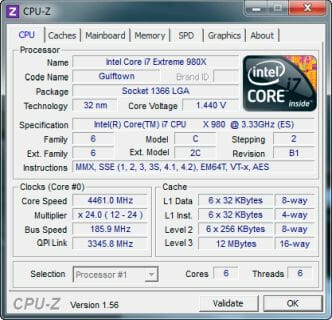
Turbo Boost and Hyper-Threading technologies were disabled during our test session. The memory voltage was at 1.64 V and its frequency was 1.49 GHz (7-7-7-16_1T timings). All other parameters available in the mainboard BIOS and related to CPU or memory overclocking remained unchanged.
All tests were performed under Windows 7 Ultimate x64 operating system. We used the following software during our test session:
- Linpack 64-bit with LinX shell version 0.6.4 – to create maximum CPU load (5 Linpack runs in each cycle with 4750 MB RAM capacity involved);
- Real Temp GT 3.60 – to monitor the processor core temperature;
- CPU-Tweaker 1.5 – to visually monitor temperatures and frequencies using graphics.
So, the complete screenshot during the test session looks as follows:
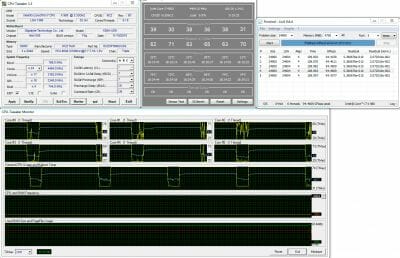
The CPU was loaded with two consecutive Linpack x64 test runs with the settings as indicated above. The stabilization period for the CPU temperature between the two test cycles was about 8-10 minutes. We took the maximum temperature of the hottest CPU core for the results charts. Moreover, we will also provide a table with the temperature readings for all cores including their average values. The ambient temperature was checked next to the system case with an electronic thermometer with 0.1 °C precision that allows hourly monitoring of the temperature changes over the past 6 hours. The room temperature during our test session varied between the annoying 23.4-23.8 °C.
We are going to compare Thermalright Archon against ThermoLab Baram 2010, which is one of the best coolers with similar design:
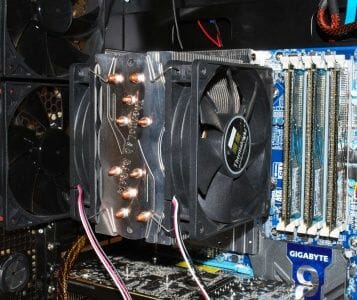
This cooler was tested with two Thermalright TR-FDB 120 mm fans, which were installed for air intake and exhaust with the airflow directed towards the back of the system case. All tests were performed in two modes: at 1200 RPM and at maximum rotation speed of 2000 RPM.
As for our today’s hero, Thermalright Archon, we tested it with its default Thermalright TY-140 fan at 600, 800, 1000 and ~1300 RPM. Besides that, we also ran the tests with two such fans in the same speed modes and with two powerful Scythe Slip Stream 140 (SM1425SL12H) fans at the maximum speed of 1690 RPM:
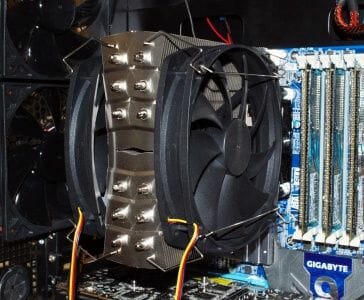
Of course, we couldn’t help including the results of the ultimate winner – Thermalright Silver Arrow cooler tested with two TY-140 fans in two speed modes: in quiet mode at 810 RPM and in maximum speed mode at 1310 RPM. I would also like to add that all fan speeds were set by changing the voltage of our special controller with ±10 RPM precision.
Cooling Efficiency Tests
The obtained results are summed up in the following table and diagram:
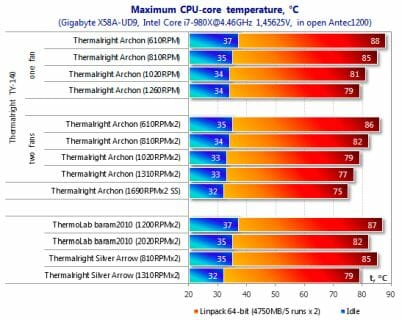
First let me say a few words about the cooling efficiency of the new Thermalright Archon depending on the number of cooling fans and their rotation speed. I can state that with one 140 mm fan as well as with two fans the cooling efficiency of Thermalright Archon increases almost linearly in the interval from 600 to the maximum 1300 RPM. Step-by-step increase in the rotation speed with 200 RPM increments allows to lower the peak processor temperature by 3-4°C and only in the very last increment when we increase the speed to 1300 RPM the temperature drops by only 2°C instead of 3-4°C as before. When we add a second fan at the same rotation speed the temperature drops by additional 2-3°C. This isn’t a big improvement, but considering the maintained low noise level it is very valuable. With a couple of high-speed Scythe Slip Stream 140 fans, the cooling efficiency of Thermalright Archon improves by another 2 degrees compared with what can be achieved with a pair of Thermalright TY-140 fans at 1310 RPM.
Of course, we are particularly interested in comparison the obtained results against those of the today’s best air-coolers. With one default 140 mm fan the new Thermalright Archon didn’t yield even 1 degree to Thermalright Silver Arrow super-cooler in its default configuration with two such fans! This is a pretty impressive result for a single-array tower cooler, don’t you think so? But Archon looks even more impressive with two fans: it simply cools an overclocked six-core processor better than Silver Arrow by 3°C in quiet mode at 810 RPM and by 2°C at maximum 1310 RPM speed of two TY-140 fans. The difference is small, but if you have been reading our reviews, you should remember that Silver Arrow had about the same advantage over Noctua NH-D14, which remained the best of the best for almost 9 months! I believe I don’t have to tell you that ThermoLab Baram 2010, which used to be the most effective single-array cooler out there is no far behind Archon.
Conclusion
Well, what can I say? Thermalright designed a truly magical cooler. Although two-array heatsinks are currently extremely popular, Archon turned out just as efficient as Silver Arrow, and with two fans attached to it, it proved even more efficient. In our opinion, there are several factors behind this impressive victory. Firstly, it is very smart heatpipe layout inside the heatsink that allows distributing the heat over the heatsink more evenly. Secondly, we shouldn’t forget about thick 0.5 mm heatsink plates soldered to the heatpipes. Thirdly, it is the use of an extremely effective Thermalright TY-140 fan. And the fourth factor is cooler’s reliable retention providing very secure hold and impeccably polished contact surface of the base plate. All these factors combined allowed Thermalright Archon to become the today’s most effective cooling product. Of course, we shouldn’t also forget that the bent base of the cooler could have turned out to be an ideal fit for the non-lapped heat-spreader of our test CPU. However, this is highly unlikely.
Among the drawbacks of the new Thermalright Archon we should definitely mention its height: not every system case out there can successfully accommodate a 170 mm tall cooler. Moreover, the price tag of $79.95 seems to be a little too high, even though Thermalright products have always been on the pricy side. And the last but not least, we wish Thermalright could design a similar cooler that would be 5-10 mm shorter, but at the same time 20 mm wider. The shorter “Archon SE” would easily fit into most cases, and by making the heatsink 10 mm wider on each side they could increase the effective heatsink surface size significantly but at the same time still avoid blocking the closest memory DIMM slot.
We realy liked this cooler. In fact, it proved to be the best cooler out there today. Unfortunately, the drawbacks we pointed out above do not allow us to crown Thermalright Archon with the Editor’s Choice, but we are happy to award it with our Ultimate Innovation title.
